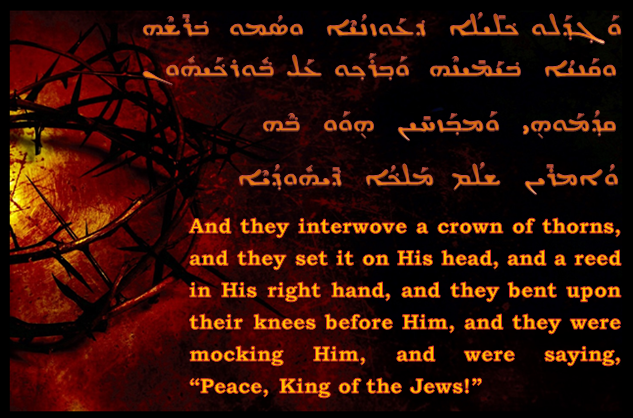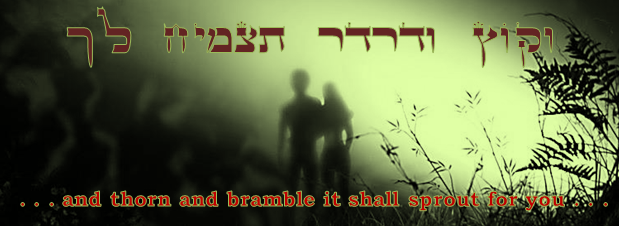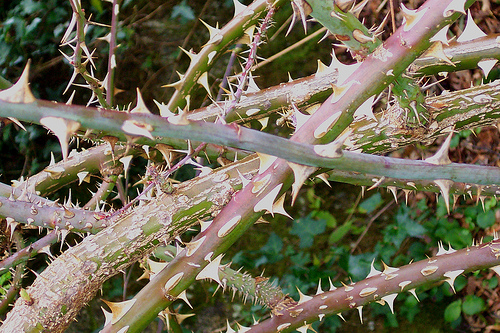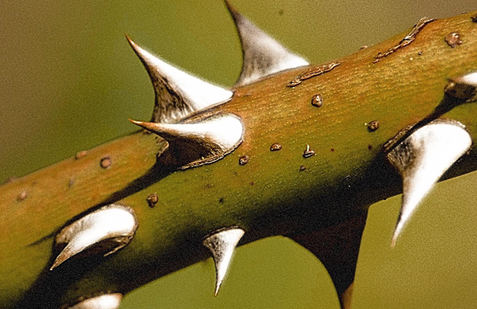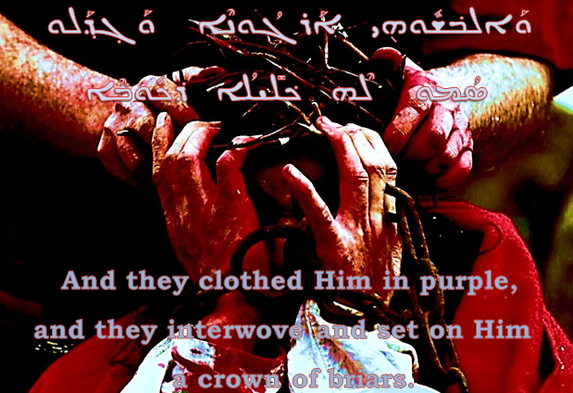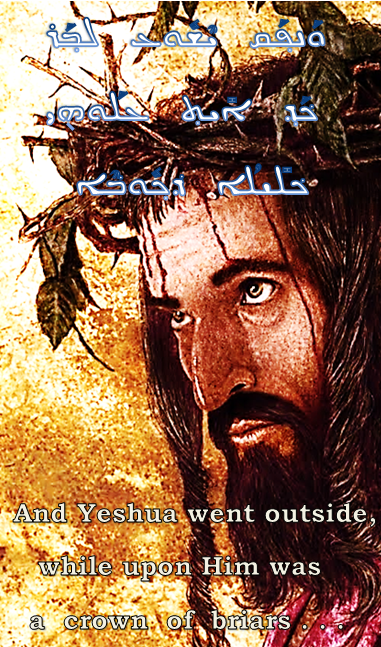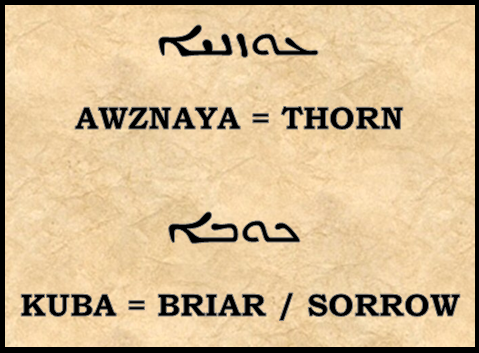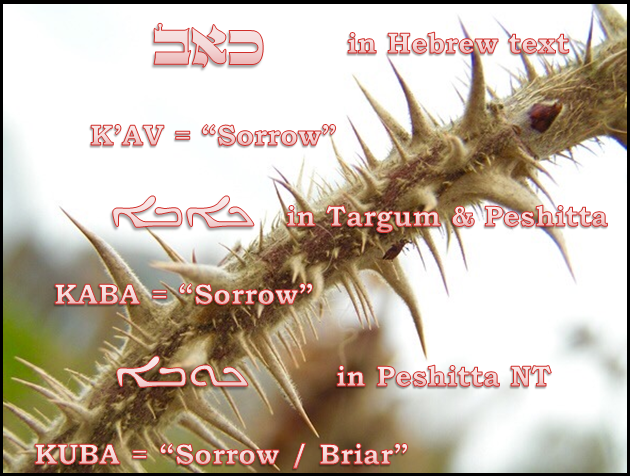CROWN OF SORROWS
by Jeremy Chance Springfield
11/8/2015
The Messiah suffered great physical atrocities in His flawless obedience that bought the souls of men back from the grave. The afflictions that led Him to the cross, and the horrors experienced there are beyond our comprehension. We read in the prophetic books clearly of His piercing, of the physical abuse endured, and all the torment involved. One of the torments that cannot be separated from the events of the crucifixion, however, and yet is not explicitly stated in the prophetic books, is the crown of thorns that was forced upon the head of Messiah during the mockery and abuse immediately prior to His journey to the tree. This torture is first mentioned in the book of Matthew 27:29, where we read from the Aramaic Peshitta text the following:
This evil action was not done out of baseless intent to harm, however. While the soldiers perhaps may have acted out of cruel perversity of what they were accustomed to seeing as a pleasant victory wreath for the Caesars, something far more significant was actually taking place with choice to have Him bear the crown of thorns. The soldiers responsible for doing this were performing unwittingly a deeply spiritual deed that is embedded in the Hebrew Scriptures in a very unique way. Returning all the way back to the beginning, to the book of Genesis, we find in 3:17-18 the cursing of the ground that was handed out by the Creator due to the sin of the man, part of which entailed this harsh sentencing:
The earth would experience a unique curse of mutation and death that it did not before know. Mutation of formerly beneficial plants arose to produce a malicious growth of thorn that would only bring sorrow and pain to man, who would be forced to contend with its pernicious and prolific growth while he attempted to grow edible plants from the earth. The presence of thorns upon the ground displayed the fact that mankind no longer had dominion over the earth. Rather, the earth was exerting enmity towards its former guardian. The world was no longer under his control.
The Messiah wearing a crown of thorns has been commented on by many wise and perceptive readers of Scripture in connection to the curse of the ground. With His bearing the thorny crown, He was showcasing that the earth itself was to be redeemed from the curse Adam brought upon it in his disobedience. The harsh reality of sin was held up and displayed for all to see: this is the cursed-earth crown with which fallen man crowned the only unfallen Man ever to walk this earth. It is ironic, and yet the importance of it cannot be overlooked.
A further insight can be gleaned by looking at the two other instances where the crown of thorns is mentioned as being worn by the Messiah. The first is Mark 15:17, which says:
This verse is linked to the third and final reference to the crown of thorns, found in John 19:5.
In both of these passages, the word translated as “briars” is notably different than the term used in Matthew for “thorns.” I have translated the term in Mark and John with a slightly different word to convey the subtle difference in meaning. There is no different term used between these texts in their Greek parallels (it is STEPHANOS in all three accounts between the various Greek texts), which shows that the Aramaic Peshitta text has preserved an original detail very much worthy of our attention.
The use by Matthew of the term AWZNAYA in Aramaic for “thorn” is a straight-forward presentation of what was placed upon the head of Yeshua. The word there means just that – “thorns.” It is only in turning to the unique choice of wording found in Mark and John that an important detail can be gleaned about the reason He had to bear such a thorny crown. The word used in both of those accounts is the term KUBA, which, while essentially being an Aramaic synonym for “thorn,” and which I have translated as “briar” above to highlight the detail for the reader, yet also possesses a secondary meaning that helps us to see a little bit deeper into what was happening. The secondary meaning of the root word for KUBA “thorn / briar,” is the notable idea of “sorrow.”
The use by Matthew of the term AWZNAYA in Aramaic for “thorn” is a straight-forward presentation of what was placed upon the head of Yeshua. The word there means just that – “thorns.” It is only in turning to the unique choice of wording found in Mark and John that an important detail can be gleaned about the reason He had to bear such a thorny crown. The word used in both of those accounts is the term KUBA, which, while essentially being an Aramaic synonym for “thorn,” and which I have translated as “briar” above to highlight the detail for the reader, yet also possesses a secondary meaning that helps us to see a little bit deeper into what was happening. The secondary meaning of the root word for KUBA “thorn / briar,” is the notable idea of “sorrow.”
This detail provides us with the alternative concept of a crown of “sorrows” being placed upon the head of the Messiah! It is entirely appropriate to look at in that way, for it shows us the result of our sins, of the curse upon the earth, is truly that of sorrow. Upon His head, Messiah bore a crown representing sorrow for all that man has done to this world and the ways of the Holy One. The crown of thorns is a crown of sorrows in every way!
The reader may also be thinking of the prophecy about the Messiah’s suffering that is recorded for us in the book of Isaiah chapter 53. In that wrenching account of what Messiah would go through to redeem men, it links Him twice to sorrows. In 53:3, He is called ISH MAK’OVOTH (a Man of sorrows), and in 53:4, He is said to have MAK’OVEYNU S’VALAM (bore our sorrows). He truly bore the burden of sorrow upon His head with the crown of thorns. Amazingly, the word used in both of these verses for “sorrows” is the exact same cognate root from whence the Aramaic term for “sorrow / briar” comes! The word in Hebrew arises from the root K’AV, meaning just “sorrow.” While it does not specifically mean “thorn / briar” in the Hebrew language, it did come to take on that additional meaning in the Aramaic language, and the fact that such a root is present in Isaiah 53:3-4 is important to consider. Even the Aramaic text translated from the Hebrew of Isaiah 53:3 – both the Targum Yonatan and the Peshitta, use the same Aramaic concept of “sorrows / briars.” This statement in the book of the prophet Isaiah was a powerful hint of what was to come – of how our sorrows would be borne by the Messiah!
The reader may also be thinking of the prophecy about the Messiah’s suffering that is recorded for us in the book of Isaiah chapter 53. In that wrenching account of what Messiah would go through to redeem men, it links Him twice to sorrows. In 53:3, He is called ISH MAK’OVOTH (a Man of sorrows), and in 53:4, He is said to have MAK’OVEYNU S’VALAM (bore our sorrows). He truly bore the burden of sorrow upon His head with the crown of thorns. Amazingly, the word used in both of these verses for “sorrows” is the exact same cognate root from whence the Aramaic term for “sorrow / briar” comes! The word in Hebrew arises from the root K’AV, meaning just “sorrow.” While it does not specifically mean “thorn / briar” in the Hebrew language, it did come to take on that additional meaning in the Aramaic language, and the fact that such a root is present in Isaiah 53:3-4 is important to consider. Even the Aramaic text translated from the Hebrew of Isaiah 53:3 – both the Targum Yonatan and the Peshitta, use the same Aramaic concept of “sorrows / briars.” This statement in the book of the prophet Isaiah was a powerful hint of what was to come – of how our sorrows would be borne by the Messiah!
When these realities are brought forth, it becomes very clear why Messiah wore upon His head that crown of thorns. It was a wordless referral to the curse handed out in the Garden, but also, more specifically, was directly hinted at in the Hebrew text and Aramaic translation of Isaiah 53:3-4! The crown of thorns was thus not a cruel mockery imagined first in the minds of the heartless soldiers on that dark day, but was a prophetically-planned event to show us that all our sorrows were borne by our King with a crown no other king would ever dare allow to be placed upon their head. Only the true King of Kings could willingly wear such a crown of sorrows! He is worthy of all praise for His obedience to the Father and His dedication to our deliverance!
All study contents Copyright Jeremy Chance Springfield, except for graphics and images, which are Copyright their respective creators.
